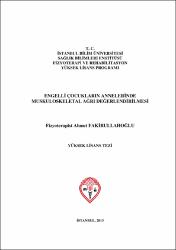| dc.contributor.advisor | Üçsular, Ferda Dokuztuğ | en_US |
| dc.contributor.author | Fakirullahoğlu, Ahmet | |
| dc.date.accessioned | 2014-06-18T11:11:48Z | |
| dc.date.available | 2014-06-18T11:11:48Z | |
| dc.date.issued | 2013 | |
| dc.date.submitted | 2013 | |
| dc.identifier.citation | Fakirullahoğlu, Ahmet. (2013). Engelli Çocukların Annelerinde Muskuloskeletal Ağrı Değerlendirilmesi. Yayımlanmamış yüksek lisans tezi. İstanbul : İstanbul Bilim Üniversitesi, Sağlık Bilimleri Enstitüsü. | en_US |
| dc.identifier.uri | https://hdl.handle.net/11446/151 | en_US |
| dc.description | İstanbul Bilim Üniversitesi, Sağlık Bilimleri Enstitüsü, Fizyoterapi ve Rehabilitasyon Programı. | en_US |
| dc.description.abstract | Engelli bireyler çevrelerini birçok yönden etkileyebilmektedir. Engelli bireylerin ihtiyacını karşılamada annelerin primer rolü üstlenmesi nedeniyle anneler fiziksel ve psikolojik açıdan normal bireylere göre daha fazla risk altındadırlar. Özellikle ambule olamayan engelli bireyler annelerde daha fazla fiziksel yüke neden olmaktadırlar. Bu çalışmanın amacı engelli çocukların ambulasyon seviyesinin annelerde ortaya çıkan muskuloskeletal ağrı üzerine etkisini belirlemektir. Çalışmaya ambule olabilen engelli çocuğa sahip 25 anne ve ambule olamayan engelli çocuğa sahip 25 anne olmak üzere toplam 50 anne alınmıştır. Kooperasyon ve adaptasyonu tam sağlayamayan, son bir yıl içerisinde ameliyat geçirmiş olan kişiler çalışmaya alınmamıştır.
Bireylerin demografik bilgileri kaydedildikten sonra ağrı değerlendirmeleri Mc Gill Ağrı Ölçeği ile yapılmıştır Araştırmaya katılan annelerin yaş ortalaması 38,60 ± 7,46 yıl ve Vücut Kitle İndeksi (VKI) ortalaması 27,24 ± 5,09 kg/m2 dir. Araştırmaya katılan bireylerde sırasıyla en çok bel, bacak, boyun ve kol bölgelerinde ağrı olduğu belirlenmiştir. Bireylerin eğitim durumu ve gelir durumunun ağrıyla bir ilişkisi bulunmamıştır. Bireyler ağrılarını azaltan faktörleri dinlenme (% 48), hafif egzersiz (% 16) ve ilaç kullanımı (%16) olarak sıralarken ağrılarını artıran faktörleri ağır kaldırmak (% 40), uzun süre ayakta durmak (% 18) ve uzun süre çalışmak (%18) olarak ifade etmişlerdir. Araştırma sonunda bireylerin ortalama 2,5 (1-5) çocuğa sahip olduğu ve çocuk sayısı ile ağrı şiddeti skoru arasında bir ilişki olduğu (r=0,386 ; P=0,006) saptanmıştır. Araştırmaya alınan engelli çocukların yaşı (rs = 0,304, p = 0,032) ve özürlülük süresi (rs = 0,299, p = 0,035) ile bireylerin ağrı şiddeti skoru arasında da bir ilişki olduğu saptanmıştır.
Bu araştırma engelli çocuğu olan annelerde muskuloskeletal ağrının ortaya çıkmasında engelli çocuğun ambule olup olmadığından daha çok, engelli çocuğun yaşının ve çocuğun engellilik süresinin etki ettiğini ortaya çıkarmıştır. Ayrıca engelli çocuk yanında sahip olunan engelli olmayan çocuk sayısı artarsa, engelli çocuğun ambule olup olmamasına bağlı olmadan annede ağrı görülme oranının arttığı belirlenmiştir. | en_US |
| dc.description.abstract | Disabled individuals can affect their surroundings in many ways. Mothers are under risk physically and psychologically more than other individuals due to the fact that they play the primary role to provide the necessities to the disabled. Specifically, the disabled individuals who cannot ambulate causes more physical burden on the mothers. In this study, we aim to determine the effect of the ambulation level of disabled children on the musculoskeletal pain that occurs on the mothers. We study on 50 mothers, 25 of which have disabled children who can ambulate, and 25 of which have disabled children who cannot ambulate. In the study, we did not include the disabled who cannot fully cooperate and adapt, and who are operated in the last year.
After recording the demographic information of the individuals, the pain level evaluation is conducted by using the McGill Pain Questionnaire. The study is conducted on a group which has average age of 38.60 ± 7.46 years, average BMI of 27.24 ± 5.09 kg/m2. The study shows that the individuals mostly complain about the pains on waist, legs, neck, and arms, respectively. We could not find any correlation between the education and income level and the pain level of the individuals. The individuals state that the factors that reduce the pain are resting (48%), light exercising (16%), and taking medicine (16%), and the factors that increase the pain are lifting weights (40%), standing for a long time (18%), and working for a long time (18%). The mothers who are studied have average children of 2.5 (1-5) and there is a significant correlation between the number of children and the pain level (r=0.386; P=0.006). There is also a significant correlation between the age of children (rs = 0.304, p = 0.032) and the length of time of disability (rs = 0,299, p = 0,035) and the pain level.
This study discovers that the age of the disabled child and the length of time of disability affect the occurrence of the musculoskeletal pain of mothers who have disabled child rather that whether the child can ambulate or not. Furthermore, if the number of non-disabled children besides the disabled child increases, it is determined that the pain level of the mother increases no matter the disabled child can ambulate or not. | en_US |
| dc.language.iso | tur | en_US |
| dc.publisher | İstanbul Bilim Üniversitesi, Sağlık Bilimleri Enstitüsü. | en_US |
| dc.rights | info:eu-repo/semantics/openAccess | en_US |
| dc.subject | kas ağrısı | en_US |
| dc.subject | ambulasyon | en_US |
| dc.subject | engelli çocuklar | en_US |
| dc.subject | muskuloskeletal ağrı | en_US |
| dc.title | Engelli çocukların annelerinde muskuloskeletal ağrı değerlendirilmesi | en_US |
| dc.type | masterThesis | en_US |
| dc.department | DBÜ, Sağlık Bilimleri Enstitüsü, Fizyoloji Ana Bilim Dalı | en_US |
| dc.relation.publicationcategory | Tez | en_US |
| dc.identifier.yoktezid | 454969 | en_US |


















